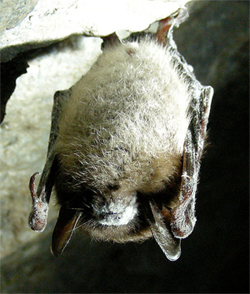Mysterious Disease Closes Caves Statewide
By JoshMogerman in News on May 2, 2010 5:45PM

Little Brown Bat with White Nose Syndrome via Wikipedia Commons
"The evidence collected to date indicates that human activity in caves and abandoned mines may be assisting the spread of white-nose syndrome," said IDNR Director Marc Miller. "The State of Illinois through the IDNR, working in conjunction with the U.S. Fish and Wildlife Service and the U.S. Forest Service, is taking steps to reduce the risks of further spread of WNS. This will involve the complete closure of all IDNR-owned and managed caves for the foreseeable future."
Similar measures were taken in Iowa and Missouri. Caves in Indiana and Tennessee had already been closed for some time, making these dark days for the region’s spelunkers.
But these actions could be extremely important.
After an intensive effort to find the source of the bat epidemic, the leading hypothesis is that the fungus was somehow accidentally introduced from Europe, which would support the concept of humans also helping to move it from cave to cave. When white nose syndrome was first identified in New York State, entire hibernacula (caves with colonies of hibernating bats) had been wiped out by the fungus, which scientists believe wakes the animals up early forcing them to expend precious energy and freeze to death.
Why bats and their noses? Nobody is completely sure, but many researchers believe that the cool, wet environment that bats choose to hang out in is ideal for the fungus:
"It grows slowly just like mold grows on your cottage cheese in the refrigerator," said David Blehert, director of diagnostic microbiology at the US Geological Survey National Wildlife Health Center in Wisconsin and the lead author of [a report on the phenomenon].
And why should you care? Beyond the sheer weirdness and grossness of this creepy phenomenon, which is oddly similar to the ongoing mysterious disappearance of honeybees, bats are pretty important. They are pollinators, seed dispersers, and excellent at pest control. Many species eat more than half their weight in insects every evening. According to Bat Conservation International, a single little brown bat can eat more than 1,000 mosquito-sized insects every hour. With concerns about West Nile Virus and other mosquito-borne diseases in these parts, we need all the bats we can get.